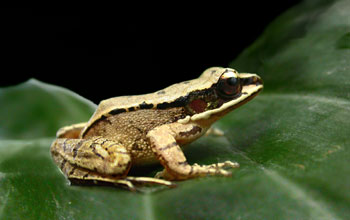Multimedia Gallery
Ultrasonic Communication Among Frogs (Image 1)
Ultrasonic Communication Among Frogs (Image 1)
The Chinese concave-eared torrent frog, the first amphibian known to communicate in ultrasound.
Albert Feng, a molecular physiologist at the University of Illinois at Urbana-Champaign (UIUC), discovered that concave-eared torrent frogs can communicate ultrasonically--at frequencies five times higher than humans can hear--making them the first non-mammalian species documented to communicate using ultrasonic sound.
Most amphibians, birds and reptiles have a hearing limit of about 12 kilohertz, but some mammals including bats and whales use ultrasonic frequencies for communication. Humans generally cannot hear sounds above 20 kilohertz. Feng believes these amphibians--who spend most of their time near mountain streams in China's Huangshan Hot Springs--developed the ability to communicate using frequencies great than 128 kilohertz so they could be "heard" over the background noise created by the water.
Feng's research is partly funded by the Collaborative Research in Computational Neuroscience (CRCNS) program, a joint effort of the National Science Foundation and the National Institutes of Health. The program supports innovative, interdisciplinary research that will yield a better understanding of how nervous systems function normally as well as when diseased. To learn more about Feng's research, see the UIUC news release "Rare Chinese Frogs Communicate by Means of Ultrasonic Sound." (Date of Image: 2005) [One of 2 related images. See Next Image.]
Credit: Albert Feng
Images and other media in the National Science Foundation Multimedia Gallery are available for use in print and electronic material by NSF employees, members of the media, university staff, teachers and the general public. All media in the gallery are intended for personal, educational and nonprofit/non-commercial use only.
Images credited to the National Science Foundation, a federal agency, are in the public domain. The images were created by employees of the United States Government as part of their official duties or prepared by contractors as "works for hire" for NSF. You may freely use NSF-credited images and, at your discretion, credit NSF with a "Courtesy: National Science Foundation" notation.
Additional information about general usage can be found in Conditions.
Also Available:
Download the high-resolution JPG version of the image. (1.5 MB)
Use your mouse to right-click (Mac users may need to Ctrl-click) the link above and choose the option that will save the file or target to your computer.



